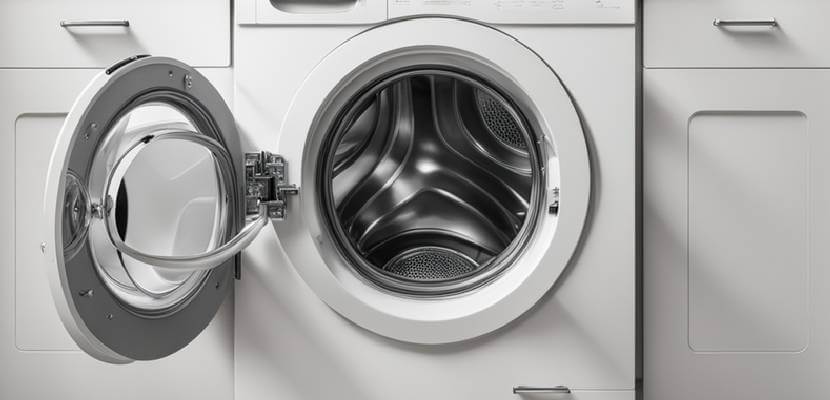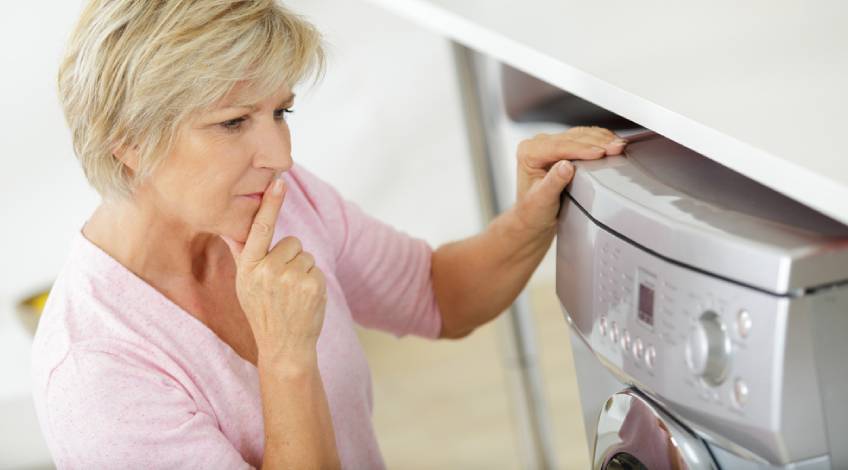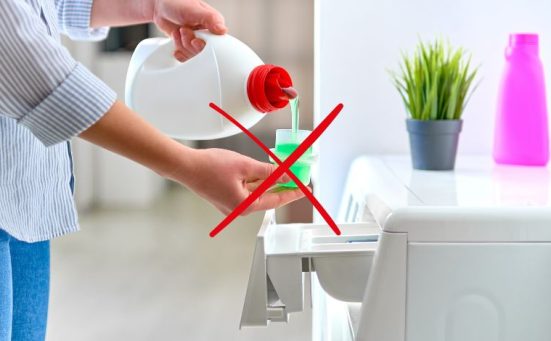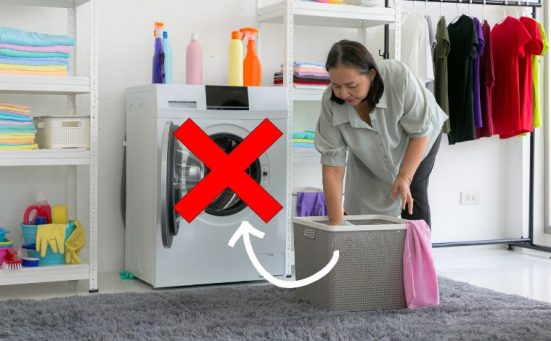
Washing Machine Won’t Turn On? (here’s why & what to do)
If you have a pile of laundry to wash and your washing machine won’t turn on, I understand how annoying it is. Which is why I put this article together, to help you get your washer working properly again.
There are several reasons why your washing machine might not start from simple electrical issues to more involved technical problems, I cover them all so keep reading.
Why Won’t The Washing Machine Turn On?
There are a number of reasons why your washing machine won’t start which include;
| Probable Cause | Solution |
|---|---|
| No Power | Check the power cord, plug, plug socket, circuit breaker and make sure your home is receiving electricity |
| Child Lock Activated | Deactivate the child lock |
| Blocked Drainage System | Check the drain filter, drain hose, waste pipe and/or drain pump and remove any blockages |
| Defective Door Switch | Inspect and replace the door switch if necessary |
| Defective Control Knobs | Check and replace any damaged control knobs |
| Overheated Washing Machine | Allow at least two hours for the appliance to cool down |
| Blown Thermal Fuse | Check and replace the thermal fuse if it proves to be faulty |
| Defective Motor | Check and repair/replace the motor if necessary |
| Malfunctioning Control Board | Inspect the control board and replace if necessary |
Let’s take a closer look at each of these issues;
No Power

Your washing machine won’t turn on if it isn’t receiving any power. This could be caused by any number of things including;
- A Power Cut Or Outage
Check another appliance or anything electrical like a light or lamp to see if there is power being supplied to your home. If nothing electrical works there’s a strong possibility that there is a power outage or power cut in your area. - Damaged Power Cord
Over time, the power cord attached to your washer could become damaged or frayed which could prevent any power running to the washer. Disconnect the plug from the wall socket or switch the circuit breaker to the off position before inspecting the power cord. If it is damaged, it will need to be replaced. - A Faulty Plug Socket
If the power cord is not damaged, check the wall socket. Try plugging something else into it like a lamp to check whether the plug socket is defective. - A Tripped Circuit Breaker
The circuit breaker is designed to trip to protect the home’s electrical circuit from serious damage. Check to see if the circuit breaker for the washing machine has tripped to the off position. Flip it back to the on position but beware, the breaker usually only trips if there is something wrong. If it continues to trip, contact a technician to investigate.
Child Lock Activated
Washing machines have safety features like the child lock or control lock as it’s also known. The child lock is designed to prevent accidental damage to the appliance by pressing buttons, interrupting cycles or turning the appliance on accidentally.
Once the child lock is activated, the washer might light up, but none of the functions will work. If the child lock is the cause of the problem, all you need to do is deactivate the control lock to get the appliance working properly again.
Consult your user manual for model specific instructions on how to deactivate the child lock on your washing machine.
Blocked Drainage System

Modern washing machines run certain diagnostic checks before starting as a safety feature. One of these checks is to ensure the drainage system is functioning correctly.
If your washer won’t turn on, it could be due to a malfunction somewhere within the drainage system. You need to check;
- The Drain Filter
Consult your user manual for the location of the drain filter (typically at the bottom front of the appliance behind a flap). Carefully remove the filter after placing a bowl on the floor to catch any water that’s in the filter housing. The filter should then be washed under fast running water to remove any debris. - The Drain Hose
If the drain hose is twisted or kinked it can cause detergent and other debris to build up and cause a blockage in the hose. Inspect the drain hose for any twists or kinks and straighten any that you find. If the drain hose is blocked, you might need to run a plumber’s snake through the hose to remove any blockage. - The Waste Pipe
If your washing machine’s drain hose is connected to the waste pipe under your kitchen sink, it’s possible that this is where the blockage is. To clear any blockage you can use a plunger, plumber’s snake or commercial drain cleaner. - The Drain Pump
The drain pump on a washing machine forces all of the wastewater from the appliance. If it becomes blocked or develops a fault, it can prevent the washer from turning on. I recommend contacting a technician to investigate further.
Defective Door Switch

The washing machine will not start until the door switch sends a message to the control board signifying it is fully closed. The first thing to check is whether there are any items between the door and the body of the appliance preventing the door from fully closing.
This could be a stray item of clothing sticking out of the drum, stray lint fibres in the door rubber, dried detergent in the door rubber or even mould spores.
Remove any items that may be causing the door to not shut properly and then check the catch is working properly. If the door still does not lock shut correctly, you will need to check the switch and latch for continuity using a multimeter.
If this is a step too far, I recommend contacting a technician to do it for you.
Defective Control Knobs (start switch & timer)
When you stop to think about it, the control knobs and buttons on your washer take a lot of punishment over the years. Over time the control knobs, buttons and switches can lose contact with their component parts, or wires could short out causing a breakdown in communication with the control board.
The start switch is the most likely candidate here as it is used the most. If you suspect the start switch is at fault have it checked and replaced if necessary.
In some cases, the timer can become faulty but this is relatively rare. You can check the various buttons and knobs using a multimeter but as there are so many electrical connections and wires, I recommend leaving this to a technician to investigate.
Overheated Washing Machine

If you have been using the washing machine for an extended period, it could simply be a case of it overheating. Many appliances have a safety shut off to prevent damage due to overheating.
If you suspect that this could be the cause of the problem, try waiting a couple of hours before using the washer again.
Blown Thermal Fuse
The thermal fuse is another safety device installed in washing machines to prevent serious damage. If the temperature inside the appliance becomes too high, the thermal fuse will blow, cutting the power to the appliance.
Unfortunately, if the thermal fuse does blow, the washer will not work until it has been replaced. As replacing the thermal fuse entails dismantling parts of your appliance, I recommend getting a technician to do it for you.
Defective Motor
The washing machine’s motor powers the drum as well as the water and drain pump. If the motor develops a fault, the washer will not start. This is often accompanied by a buzzing or whining noise.
Users who regularly overload their washing machines are most likely to experience motor issues with their appliances.
The motor is a major component on a washing machine and as such any inspection, repair or replacement should be carried out by a technician.
Malfunctioning Control Board

All of the washing machine’s functions are controlled by the control board. If the control board malfunctions, the washer won’t turn on. In some cases this can be caused by an electrical glitch or software issue.
Software issues or electrical glitches can often be cleared by performing a reset. This involves disconnecting the power supply for 10 to 15 minutes to allow any residual power to discharge.
Once the power supply has been restored, the glitch should have cleared and the washer will work as normal. However, if the reset doesn’t clear the issue, you will need to get the control board checked out.
Washing machine control boards are expensive components and easily damaged. If you have checked everything else and you suspect the issue lies with the control board, I recommend contacting a technician to investigate and advise you on your best course of action.
Depending on the age of the appliance and the cost of replacing the control board, your technician might advise you to replace the appliance as a cheaper option.
SEE ALSO: Washing Machine Beeping? Just do this…
Frequently Asked Questions
If your washing machine is not powering on it could be because; there is no power, the child lock has been activated, there is a blockage in the drainage system, the door switch is faulty, one of the control knobs is defective, the washer has overheated, the thermal fuse has blown, the motor is defective or the control board is malfunctioning.
The most common cause of washing machine failure is a blockage in the drainage system.
If your washing machine has suddenly stopped working it could be because there is a power outage or power cut, the circuit breaker has tripped, or the washer has overheated.
Also, follow us on Pinterest ...



